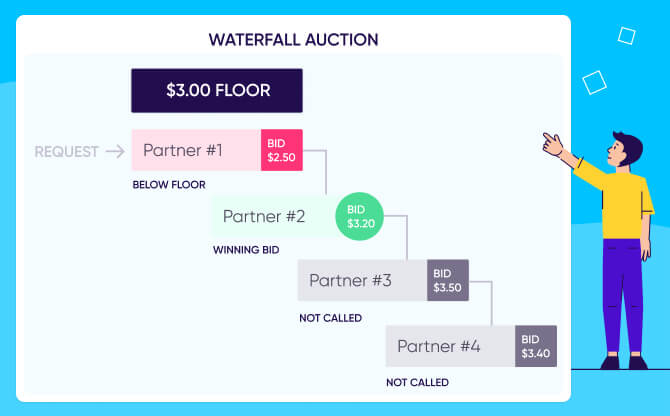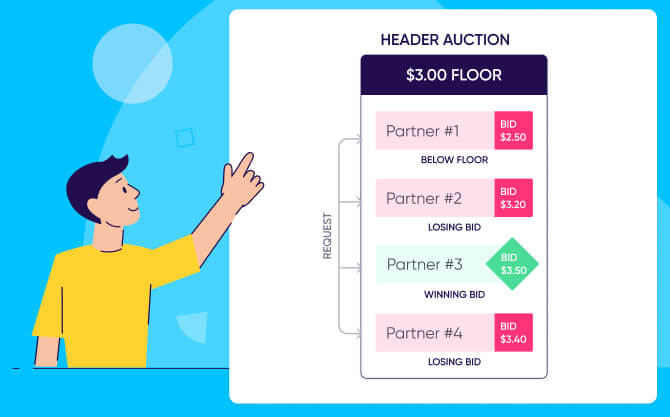
Header bidding
Also known as advanced bidding or pre-bidding, header bidding is a programmatic approach to selling advertising space in real-time where publishers auction inventory to multiple ad exchanges that bid for the highest price
What is header bidding?

Header bidding is how publishers sell advertising for the highest price at scale by creating an auction for multiple ad exchanges to bid for ad space. It’s also referred to as advanced bidding or pre-bidding. This method allows publishers to increase their yield and revenue.
For example, let’s say a sports website needs to sell advertising across their website. Instead of the manual process of selling premium ad space to a certain number of ad networks, they can sell through header bidding, which opens up opportunities for multiple ad networks to advertise and compete for premium ad space.
What are the benefits of header bidding?
Header bidding gives publishers the leverage to sell more ad space at scale. Instead of selling inventory at a fixed price manually, ad networks compete in an auction for the ad space. This maximizes the revenue potential for publishers and ensures that more ad space is sold.
On the other side of the coin, advertisers can access impression data first to optimize their campaigns in the future. Additionally, header bidding gives more advertisers access to premium inventory that otherwise may have been limited to a select few of advertisers if sold traditionally.
The waterfall programmatic era
The waterfall method, also known as daisy chaining, was the most popular method of selling ad space programmatically before header bidding.
In the waterfall method, inventory is offered to a series of ad exchanges that are ranked by average historic yield. So advertisers who paid for premium inventory at a higher price in the past would be sold to first. If the first advertiser fails to make a bid that matches the floor price set by the publisher, the offer is sent to the next ad exchange, and so on.

While fairly easy to set up, the waterfall method poses a few inefficiencies. For example, there may be an ad exchange that would pay a lot more for inventory that may be overlooked because they’re ranked lower in the chain.
Additionally, the process of passing from one ad exchange to the next in sequential order causes delays (latency) and thus slows down the performance of the app website where the ad is shown. Header bidding solves for both inefficiencies through a real-time auction that helps maximize yield and revenue.
Header bidding vs real time bidding (RTB)
Real-time bidding is the advertising method for buying and selling ads through auctions. Ads bought and sold through real-time bidding appear as webpages and apps are loaded. Header bidding is an auctioning method that utilizes real-time bidding.
How does header bidding work?

Whenever a user opens a webpage and it begins to load, an auction is triggered. The code in the header of the website is called a wrapper, which calls ad exchanges and demand partners to make a bid within milliseconds. Within this extremely short window, demand partners conduct their own auctions to establish their highest bid. Following the winning bid, the respective ad servers of the publisher and advertiser are connected, then display the ad creative in the ad slot to the end user.
What is in-app bidding?
While header bidding usually refers to websites, in-app bidding is the programmatic selling and buying of ads through a real-time auction within mobile apps. In other words, in-app bidding is header bidding done within an app.
Header bidding vs open bidding
Open bidding is header bidding where the auction takes place on the server-side rather than the publisher-side. For example, Google’s open bidding is easier to implement and does not require the complicated code infrastructure that is needed for header bidding. Instead, Google’s technology creates a unified auction with ad exchanges, supply-side platforms (SSPs), and demand partners.
The best, but not perfect solution
Header bidding is the best programmatic solution for publishers and advertisers today, but it comes with a few drawbacks. First, header bidding is very difficult to implement. And while load times are a huge improvement from the waterfall method, there’s still latency that causes delays in webpage load times especially on mobile devices.
Key takeaways
- Header bidding is a programmatic approach to selling advertising space in real-time where publishers auction inventory to multiple ad exchanges that bid for the highest price.
- As opposed to selling inventory at a fixed price, ad networks compete in an auction for ad space. As a result, publishers can maximize revenue potential and sell more ad space.
- Real-time bidding is the advertising method for buying and selling ads through auctions. Ads bought and sold through real-time bidding appear as webpages and apps are loaded.
- Header bidding relates to websites, while in-app bidding is the programmatic selling and buying of ads via a real-time auction within mobile applications


